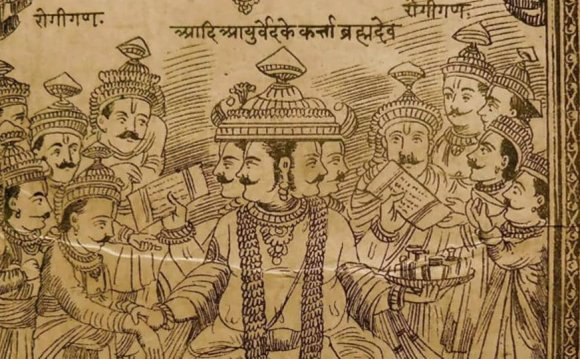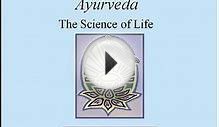
| by Dr. Vasant Lad
(originally published at ) Ayurveda is considered by many scholars to be the oldest healing science. In Sanskrit, Ayurveda means "The Science of Life." Ayurvedic knowledge originated in India more than 5, 000 years ago and is often called the "Mother of All Healing." It stems from the ancient Vedic culture and was taught for many thousands of years in an oral tradition from accomplished masters to their disciples. Some of this knowledge was set to print a few thousand years ago, but much of it is inaccessible. The principles of many of the natural healing systems now familiar in the West have their roots in Ayurveda, including Homeopathy and Polarity Therapy. The Strategy: Your Constitution and Its Inner BalanceAyurveda places great emphasis on prevention and encourages the maintenance of health through close attention to balance in one’s life, right thinking, diet, lifestyle and the use of herbs. Knowledge of Ayurveda enables one to understand how to create this balance of body, mind and consciousness according to one’s own individual constitution and how to make lifestyle changes to bring about and maintain this balance.Just as everyone has a unique fingerprint, each person has a particular pattern of energy—an individual combination of physical, mental and emotional characteristics—which comprises their own constitution. This constitution is determined at conception by a number of factors and remains the same throughout one’s life. Many factors, both internal and external, act upon us to disturb this balance and are reflected as a change in one’s constitution from the balanced state. Examples of these emotional and physical stresses include one’s emotional state, diet and food choices, seasons and weather, physical trauma, work and family relationships. Once these factors are understood, one can take appropriate actions to nullify or minimize their effects or eliminate the causes of imbalance and re-establish one’s original constitution. Balance is the natural order; imbalance is disorder. Health is order; disease is disorder. Within the body there is a constant interaction between order and disorder. When one understands the nature and structure of disorder, one can re-establish order. Balancing the Three Principle Energies of the BodyAyurveda identifies three basic types of energy or functional principles that are present in everyone and everything. Since there are no single words in English that convey these concepts, we use the original Sanskrit words vata, pitta and kapha. These principles can be related to the basic biology of the body.Energy is required to create movement so that fluids and nutrients get to the cells, enabling the body to function. Energy is also required to metabolize the nutrients in the cells, and is called for to lubricate and maintain the structure of the cell. Vata is the energy of movement, pittais the energy of digestion or metabolism and kapha, the energy of lubrication and structure. All people have the qualities of vata, pitta and kapha, but one is usually primary, one secondary and the third is usually least prominent. The cause of disease in Ayurveda is viewed as a lack of proper cellular function due to an excess or deficiency of vata, pitta or kapha. Disease can also be caused by the presence of toxins. In Ayurveda, body, mind and consciousness work together in maintaining balance. They are simply viewed as different facets of one’s being. To learn how to balance the body, mind and consciousness requires an understanding of how vata, pitta and kapha work together. According to Ayurvedic philosophy the entire cosmos is an interplay of the energies of the five great elements—Space, Air, Fire, Water and Earth. Vata, pitta and kapha are combinations and permutations of these five elements that manifest as patterns present in all creation. In the physical body, vata is the subtle energy of movement, pitta the energy of digestion and metabolism, and kapha the energy that forms the body’s structure. Vatais the subtle energy associated with movement — composed of Space and Air. It governs breathing, blinking, muscle and tissue movement, pulsation of the heart, and all movements in the cytoplasm and cell membranes. In balance, vata promotes creativity and flexibility. Out of balance, vata produces fear and anxiety. Pittaexpresses as the body’s metabolic system — made up of Fire and Water. It governs digestion, absorption, assimilation, nutrition, metabolism and body temperature. In balance, pitta promotes understanding and intelligence. Out of balance, pitta arouses anger, hatred and jealousy. Kaphais the energy that forms the body’s structure — bones, muscles, tendons — and provides the "glue" that holds the cells together, formed from Earth and Water. Kapha supplies the water for all bodily parts and systems. It lubricates joints, moisturizes the skin, and maintains immunity. In balance, kapha is expressed as love, calmness and forgiveness. Out of balance, it leads to attachment, greed and envy. Life presents us with many challenges and opportunities. Although there is much over which we have little control, we do have the power to decide about some things, such as diet and lifestyle. To maintain balance and health, it is important to pay attention to these decisions. Diet and lifestyle appropriate to one’s individual constitution strengthen the body, mind and consciousness. Ayurveda as a Complementary System of HealingThe basic difference between Ayurveda and Western allopathic medicine is important to understand. Western allopathic medicine currently tends to focus on symptomatology and disease, and primarily uses drugs and surgery to rid the body of pathogens or diseased tissue. Many lives have been saved by this approach. In fact, surgery is encompassed by Ayurveda. However, drugs, because of their toxicity, often weaken the body. Ayurveda does not focus on disease. Rather, Ayurveda maintains that all life must be supported by energy in balance. When there is minimal stress and the flow of energy within a person is balanced, the body’s natural defense systems will be strong and can more easily defend against disease.It must be emphasized that Ayurveda is not a substitute for Western allopathic medicine. There are many instances when the disease process and acute conditions can best be treated with drugs or surgery. Ayurveda can be used in conjunction with Western medicine to make a person stronger and less likely to be afflicted with disease and/or to rebuild the body after being treated with drugs or surgery. We all have times when we don’t feel well and recognize that we’re out of balance. Sometimes we go to the doctor only to be told there is nothing wrong. What is actually occurring is that this imbalance has not yet become recognizable as a disease. Yet it is serious enough to make us notice our discomfort. We may start to wonder whether it is just our imagination. We may also begin to consider alternative measures and actively seek to create balance in our body, mind and consciousness. Evaluation and Treatment of ImbalancesAyurveda encompasses various techniques for assessing health. The practitioner carefully evaluates key signs and symptoms of illness, especially in relation to the origin and cause of an imbalance. They also consider the patient’s suitability for various treatments. The practitioner arrives at diagnosis through direct questioning, observation and a physical exam, as well as inference. Basic techniques such taking the pulse, observing the tongue, eyes and physical form; and listening to the tone of the voice are employed during an assessment.Palliative and cleansing measures, when appropriate, can be used to help eliminate an imbalance along with suggestions for eliminating or managing the causes of the imbalance. Recommendations may include the implementation of lifestyle changes; starting and maintaining a suggested diet; and the use of herbs. In some cases, participating in a cleansing program, called panchakarma, is suggested to help the body rid itself of accumulated toxins to gain more benefit from the various suggested measures of treatment. In summary, Ayurveda addresses all aspects of life—the body, mind and spirit. It recognizes that each of us is unique, each responds differently to the many aspects of life, each possesses different strengths and weaknesses. Through insight, understanding and experience Ayurveda presents a vast wealth of information on the relationships between causes and their effects, both immediate and subtle, for each unique individual. General DescriptionVata provides the essential motion for all bodily processes and is extremely vital for health. On an annual basis, vata is most prominent in the fall and at the change of seasons, and these are the most important times to be careful of diet and lifestyle. One purpose of lifestyle considerations is stabilize this motion. Routine is very useful in assisting the vata individual to effectively ground all this moving energy.A person with vata predominant is blessed with a quick mind, flexibility and creativity. Mentally, they usually grasp concepts quickly but then forget them just as quickly. Alert, restless and very active, vata people walk, talk and think fast, but are easily fatigued. They tend to have less willpower, confidence, boldness and tolerance for fluctuation than other types and often feel unstable and ungrounded. When unbalanced, vata types may become fearful, nervous and anxious. In the external world, vata types tend to earn money quickly and spend it quickly. They are not good planners and as a consequence may suffer economic hardship. Vata types have variable appetite and digestion. They are often attracted to astringent foods like salad and raw vegetables, but their constitution is balanced by warm, cooked foods and sweet, sour and salty tastes. With a tendency to produce little urine, their feces are often hard, dry and small in size and quantity. Vata resides in the colon, as well as the brain, ears, bones, joints, skin and thighs. Vata people are more susceptible to diseases involving the air principle, such as emphysema, pneumonia and arthritis. Other common vata disorders include flatulence, tics, twitches, aching joints, dry skin and hair, nerve disorders, constipation, and mental confusion. Vata in the body tends to increase with age as is exhibited by the drying and wrinkling of the skin. Since the attributes of vata are dry, light, cold, rough, subtle, mobile and clear, any of these qualities in excess can cause imbalance. Frequent travel, especially by plane, loud noises, continual stimulation, drugs, sugar and alcohol all derange vata, as does exposure to cold and cold liquids and foods. Like the wind, vata types have a hard time becoming and staying grounded. Routine is difficult but essential if vata is to be lowered and controlled. It is best for vata types to go to bed by 10 pm as they need more rest than the other types. In general, people with excessive vata respond most rapidly to warm, moist, slightly oily, heavy foods. Steam baths, humidifiers and moisture in general are helpful. Daily oil massage before bath or shower is also recommended. Dietary ConsiderationsGeneral food guidelines for decreasing vata include warm, well-cooked, unctuous foods. One should have small meals three or four times a day and may snack as needed while maintaining a two hour gap between each meal. Regularity in meal times is important for vata. Those with vata-dominant constitutions do well with one-pot meals such as soups, stews and casseroles. They can use more oil in cooking their foods than the other two doshas and experience better digestion if they limit their intake of raw foods.Well-cooked oats and rice are good for vata because they are not too drying when cooked with plenty of water and butter or ghee. While cooked vegetables are best for vata, the occasional salad with a good oily or creamy dressing is all right. Nightshades—tomatoes, potatoes, eggplants and peppers—as well as spinach should be avoided if the vata person has stiff, aching joints or muscles. Sweet, ripe and juicy fruits are good for vata. The astringent and drying fruits, such as cranberries, pomegranates and raw apples, should be avoided. Fruit should always be eaten by itself on an empty stomach. Many vata people can satisfy their need for protein by judicious use of dairy products, but can also use eggs, chicken, turkey, fresh fish and venison if they wish. Legumes are difficult to digest and should be consumed in limited quantity by those trying to pacify vata. The legumes should be the split type and soaked before cooking. Cooking them with a little oil and spices, such as turmeric, cumin, coriander, ginger, garlic and hing (asafoetida), will help prevent vata from being disturbed. All nuts and seeds are good for vata, but are best used as butters or milks. Ten almonds, soaked in water overnight with skins removed the next morning, are a satisfying early morning food. Sesame oil is warming for vata, but all oils are good. All dairy products are good for vata with hard cheese being eaten sparingly. All spices are good, but should not be overused. Vatas can have half a glass of wine, diluted with water, during or after a meal. Since vata people tend to be prone to addiction, they should avoid sugar, caffeine and tobacco. Intensity itself can be intoxicating to vata, so one should seek relaxation and meditation to reduce vata. General guidelines for balancing vata:
|
RELATED VIDEO












